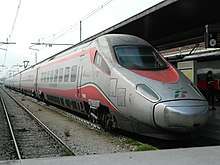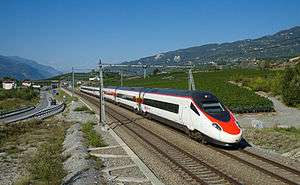New Pendolino
The New Pendolino is a class of high-speed tilting trains built by Alstom Ferroviaria (Fiat Ferroviaria) for Trenitalia, SBB, Renfe, and PKP, known as the ETR 600 / 610, RABe 503, Avant S-114 and ED250 respectively. They represent a further development of the earlier Pendolino models in order to better respond to the requirements expressed by the market and the customers of Trenitalia and Cisalpino.
| New Pendolino ETR 600 / 610 (Trenitalia) RABe 503 (SBB) Avant S-114 (Alta Velocidad Española ) ED250 (PKP) | |
|---|---|
_Lichen99.jpg) ED250 at Wrocław Główny | |
Second class interior of a PKP ED250 unit | |
| Manufacturer | Alstom |
| Built at | Savigliano (ITA) |
| Constructed | 2006 – today |
| Entered service | 2008 |
| Number built | 71 + 22 |
| Formation | 7 cars, 4 motors and 3 trailers |
| Capacity | 430 + 2 wheel chairs |
| Specifications | |
| Train length | 187.4 m (614 ft 10 in) |
| Car length | 26.2 m (85 ft 11 1⁄2 in) (total length 28.2 m or 92 ft 6 1⁄4 in) |
| Width | 2.83 m (9 ft 3 3⁄8 in) |
| Maximum speed | 250 km/h (155 mph) (service) 293 km/h (182 mph) (maximum) |
| Weight | 387 t (381 long tons; 427 short tons) 421 t (414 long tons; 464 short tons) (loaded) |
| Axle load | 16.5 t (16.2 long tons; 18.2 short tons) (with passengers) |
| Power output | 5,500 kW (7,400 hp) |
| Electric system(s) | 3 kV DC – 25 kV 50 Hz AC (ETR 600) 3 kV DC – 25 kV 50 Hz AC – 15 kV 16⅔ Hz AC (ETR 610) |
| Track gauge | 1,435 mm (4 ft 8 1⁄2 in) standard gauge |
Overview

The name Pendolino is used to identify a family of high-speed, tilting-technology trains, produced in Italy. These trains owe their name (pendolino can mean 'small pendulum' in Italian) to the mechanism enabling them to tilt when going round a curve. The maximum tilt of 8 degrees allows the trains to reach a speed that is up to 35% higher than for conventional trains, whilst assuring the greatest safety and comfort for passengers. Developed by Alstom Ferroviaria, which inherited tilting technology (including that of the British Advanced Passenger Train) after its acquisition of former producer Fiat Ferroviaria, they are built at Alstom’s Savigliano plants, in Piedmont, as well as in Sesto San Giovanni near Milan (which will supply the traction converters).
The Pendolino first began service in Italy in 1988, with model ETR 450, followed by ETR 460, ETR 470 and ETR 480. A new model generation was launched in 2006 with ETR 600 for Trenitalia and ETR 610 / RABe 503 for Cisalpino, a railway company that operated trains between Switzerland and Italy. Manufacturer Alstom labeled them as New Pendolino.
ETR 610 (Italy)/ RABe 503 (Switzerland)

The ETR 610 / RABe 503 (also known as the Cisalpino Due as it was the second class of tilting trains used by Cisalpino) primarily differs from the ETR 600 in the sense that the ETR 610 / RABe 503 supports the voltage and signalling systems used in Switzerland and Germany. This includes the need for much heavier on-board traction power transformers necessary as a result of the lower traction power frequency of 16.7 Hz used in Switzerland and Germany in comparison with those required for the 25 kV 50 Hz AC traction power supplies. The innovative features concern the interior and exterior design, now closer to the customers’ brand strategy and an improved comfort and services for passengers. Moreover, some important technical characteristics have been increased, such as the power of the traction unit and the level of redundancy of components and equipment, in order to improve reliability. The new trains will be produced in full accordance with the new regulations governing interoperability (for example, passive security in case of impact). The train is run on international routes from Switzerland to Italy and starting with the December 2017 schedule change one daily trip from Frankfurt (Main) Hauptbahnhof to Milano Centrale via the Gotthard Base Tunnel and back via Simplon Tunnel and Lötschberg Base Tunnel to Frankfurt.[1]
ED250 (Poland)
On 30 May 2011 the Polish state railways PKP signed an agreement with Alstom for 20 Pendolinos ETR 610 for delivery in 2014.[2][3] The first Pendolino was delivered on August 12, 2013.[4] The new trains, called Pendolino ED250, will operate on the route from Gdynia to Warsaw, on the high-speed CMK Central Rail Line from Kraków/Katowice to Warsaw and Wrocław to Warsaw.[5]
Polish "Pendolino" trainsets do not have tilting mechanism which precludes them from the main advantage of faster taking of curves.
High speed tests using the new Pendolino ED250 on the CMK Central Rail Line began in November 2013. On the first day of tests, November 16, the Pendolino reached 242 km/h (150 mph).[6] On 17 November 2013 a new speed record for Polish railways was set when the Pendolino ED250 reached a speed of 291 km/h (181 mph),[7] breaking the 19-year record of 250.1 km/h (155 mph). On 24 November 2013 the final day of tests on the CMK Central Rail Line the Pendolino reached 293 km/h (182 mph).[8]
The contract between the Polish operator PKP Intercity and Alstom called for the first eight Pendolino ED250 trainsets to be delivered on 6 May 2014, tested ('homologated') for operation at 250 km/h (155 mph) using European Train Control System Level 2 signalling. The tests had not been performed by May, and PKP announced that Alstom had failed to meet the contract terms and would be charged penalties as of May 6.[9] Alstom responded that homologation in Poland at 250 km/h using ETCS Level 2 was impossible, since ETCS Level 2 was not operational anywhere in Poland, and the Central Rail Line (Poland) where the first ED250 Pendolino had reached 293 km/h in testing was equipped with ETCS Level 1, not Level 2.[10] On 26 June 2014 a compromise was reached between PKP and Alstom under which the Pendolinos would be delivered under a two-stage homologation, first homologated for operation using ETCS Level 1 and eventually to be homologated for ETCS Level 2. Hopes were expressed that the Pendolinos could be in service by 14 December 2014.[11][12]
In 2020 one train did derail in Germany during an instrumedted test run.[13]
Avant S-114 (Spain)

The Avant S-114 is a four car variant of the New Pendolino design, and much like the Polish version, is not fitted with tilting mechanisms.
The thirteen trainsets are now used on high-speed services between Madrid, Segovia, and Valladolid, on the high-speed line.[14]
Technical characteristics
The trains have the following characteristics:
- Seven cars, 4 motors and 3 trailers
- Gauge: 1,435 mm (4 ft 8 1⁄2 in)
- Voltage:
- ETR 600 (Trenitalia): 3 kV DC – 25 kV AC
- ETR 610 (Swiss Federal Railways): 3 kV DC – 25 kV AC – 15 kV (16.7 Hz) AC
- Length of coach: 26.2 metres (85 ft 11 in) (total length 28.2 metres or 92 feet 6 inches)
- Total length: 187.4 m (615 ft)
- Width: 2.83 m (9 ft 3 in)
- Maximum load per axle: 16.5 t (16.2 long tons; 18.2 short tons) (with passengers)
- Weight: 387 t (381 long tons; 427 short tons)
- Total weight under normal load (with seated passengers): 421 t (414 long tons; 464 short tons)
- Maximum speed: 250 km/h (155 mph)
- Total installed power: 5,500 kW (7,400 hp)
- Seating: 430 +2 for wheel chair users
- Tilting actuating system: electro-hydraulic
- HVAC system with built-in redundancy
The new Pendolino will be fitted with the European Train Control System (ETCS) Level 2 signalling system and also SCMT, while the trains produced for the Swiss Federal Railway (ETR 610) will have ETCS, SCMT, ZUB, LZB and Integra-Signum systems.
See also
- Pendolino
- Avelia Liberty
- List of high speed trains
- China Railways CRH5, a non tilting New Pendolino
- Avant class 114, a non tilting New Pendolino
- Stamps with ETR 600
- Stamps with ETR 610
- Stamps with ED 250
References
- Frei, Stephan (2017-12-01). "Eisenbahn-Amateur | DE". Eisenbahn Amateurh (in German): 551. Retrieved 1 December 2017.
- "PKP Intercity signs Pendolino contract". Railwaygazette.com. Retrieved 29 July 2018.
- "PKP Intercity zamawia 20 pociągów New Pendolino". Gazetakrakowska.pl. Retrieved 29 July 2018.
- "Press Centre - Alstom". Alstom.com. Archived from the original on 2013-09-27. Retrieved 29 July 2018.
- "Polish high speed rail project cancelled". Railwaygazette.com. Retrieved 29 July 2018.
- Kolejowy, Kurier. "Pendolino osiągnęło na CMK 242 km/h". Kurierkolejowy.eu. Retrieved 29 July 2018.
- "291 km/h. Nowy rekord prędkości polskiego Pendolino". Tvn24.pl. Retrieved 29 July 2018.
- "Wszystko na temat branży kolejowej: PKP, Intercity, przewozy regionalne, koleje mazowieckie, rozkłady jazdy PKP, Kolej". Rynek-kolejowy.pl. Retrieved 29 July 2018.
- Kolejowy, Kurier. "Pendolino bez homologacji. Od jutra będą kary". Kurierkolejowy.eu. Retrieved 29 July 2018.
- "First ETCS certified in Poland". Railwaygazette.com. Retrieved 29 July 2018.
- "Polskie Radio Online". Polskieradio.pl. Retrieved 29 July 2018.
- "Archived copy". Archived from the original on 2014-10-06. Retrieved 2014-07-05.CS1 maint: archived copy as title (link)
- Germany, Abendzeitung. "Zug kollidiert mit Rangierlok: Lokführer in Klinik". www.abendzeitung-muenchen.de (in German). Retrieved 2020-04-09.
- https://www.elnortedecastilla.es/20110601/local/castilla-leon/renfe-estrena-nuevos-avant-201106011236.html
External links
| Wikimedia Commons has media related to |
- Pendolino – Alstom